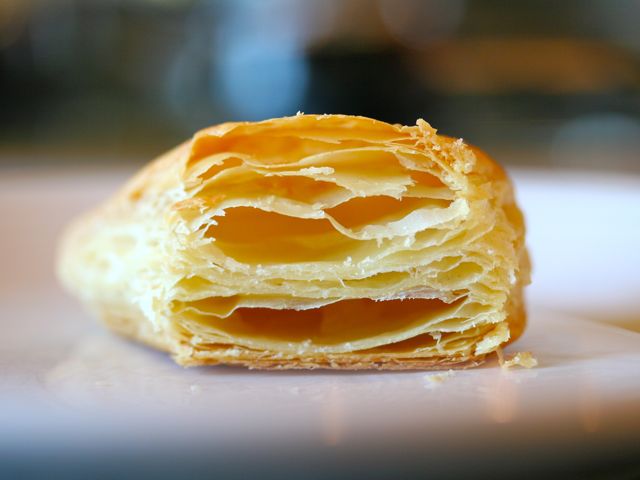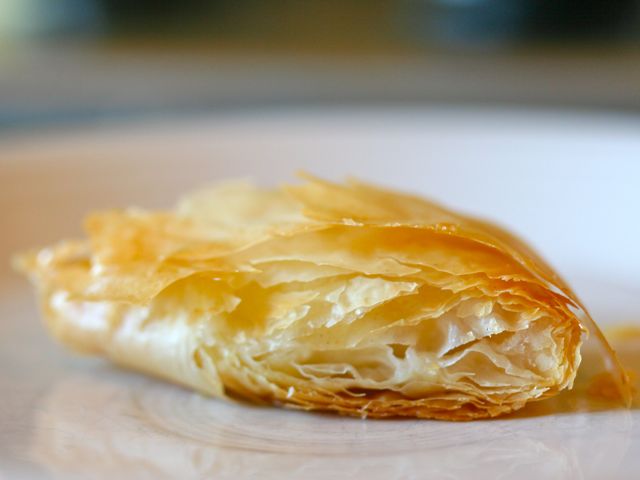
phyllo, l
(article, Hank Sawtelle)
[%pageBreakSettings nobreak=true]What's the difference between puff-pastry sheets and phyllo dough? Can they be used interchangeably? — Jamey G., Portland, Oregon I was sure I knew the answer to this question as soon as I read it; it just seems like something I should know. But when I went into my brain to access the answer, all I found were dirty jokes and Seinfeld quotes. OK, time to hit the books. Phyllo (pronounced FEE-low) and puff pastry are not identical, but they do have a lot in common. Both are made of layered, thin sheets of low-fat wheat dough. These layers are the “leaves” referred to in the words phyllo (Greek for “leaf”) and pâte feuilletée (the French name for puff pastry, which means “leaf dough” — at least sort of). When cooked (usually baked), phyllo and puff pastry both rise, as the layers separate somewhat and turn golden brown and crisp. So it's easy to imagine these products sharing a common, proto-European, layered-dough ancestry. (See also [/articles/features/strudelsecrets strudel].) |[%image phylloautopsy width=300 caption="A sidecut of phyllo."]|[%image reference-image width=300 caption="A sidecut of puff."]| |[%image phyllo width=300 caption="A phyllo triangle."]|[%image pufftriangle width=300 caption="A puff triangle."]| But there are significant differences between the two. Phyllo sheets are relatively dry, and stored (refrigerated or frozen) stacked on top of each other. The layers can be separated, and cooks can select the particular number of layers they'd like to use. [/recipes/collections/Contributors/Ivy+Manning/Beet+Greens+and+Feta+Phyllo+Pockets+with+Yogurt+Dill+Dip Recipes] often call for brushing butter or oil between the layers before reassembling them. Puff pastry, on the other hand, is a more integrated product, with thin layers of butter trapped between the sheets of wheat dough. The layers can't be separated before cooking, so what you see is what you get. Puff pastry usually contains more layers, and generally rises higher from the steam and expanding air that forms between the dough sheets. Cooked phyllo has a crisp crackle, while puff pastry has a buttery richness (think aerated pie crust). They can't always be used interchangeably, because their properties are so different. But with the understanding that you are venturing into test-pilot territory, I can't think of any reason not to experiment. In fact, it should be fun. My mom (hi, Mom!) used to make phyllo cheese puff hors d'oeuvres — crunchy triangles of salty, creamy goodness. I don't see any reason why these wouldn't work with puff-pastry dough. They'd be puffier and richer and flakier, probably more of an appetizer than a party snack. But you'd save yourself the step of brushing butter between the phyllo layers. On the other hand, crunchy and gooey [/books/collections/allbooks/The+Language+of+Baklava/Poetic+Baklava baklava], a dessert made from phyllo, walnuts, and honey, might not work so well with puff-pastry dough. First of all, you can't separate the layers to get walnuts between them. And the gravity of rich, buttery puff pastry smothered in rich, sticky honey syrup would be overwhelming. (Or would it? Hmmm.) From the puff-pastry angle, a tartlet or other savory-topped thing should work, in its own way, with phyllo. You'd probably want to brush some butter or oil between the layers to avoid extreme dryness, but the result would still be lighter and crisper than the puff-pastry version. (Phyllo also needs to be protected with a damp towel when you're not actively working with it, or it will dry out and crumble.) Some applications, however, pretty much demand puff pastry. Can you imagine a buttery, tender croissant (essentially a puff-pastry triangle rolled and shaped into a crescent) executed in crunchy, dry phyllo dough? I cannot. Although [/articles/features/howtomakepalmiers palmiers], the flat, heart-shaped, rolled puff-pastry cookies, might fall into the just-crazy-enough-to-work-with-phyllo category. Jamey, I nominate you to try it and let us know. There are countless yards of frozen phyllo and puff pastry available in most supermarkets and at some bakeries, but what if you're masochistic enough to make it yourself? (One reason you might decide to is that Pepperidge Farm, the most common grocery-store brand of puff pastry, is made with palm and soybean oils instead of butter.) Puff pastry is made by hand at hardcore bakeries. I'm not going to lie to you: it is a pain to produce. The method involves encasing a brick of butter in a jacket of dough and then repeatedly rolling it out and folding it over onto itself until you have a bazillion layers. Sounds easy enough, but temperature control and rolling technique are crucial; if done incorrectly, the layers will fuse and the result is basically a very tough pie dough. Nonetheless, I have done it, mainly just to prove I could. (In everyday life, I just buy it at the store.) The best description of the process I have found is in the book [/books/collections/allbooks/puff Puff],_ by Martha Holmberg. Homemade phyllo recipes are more elusive. The paper-thin sheets of store-bought phyllo can't be realistically produced without specialized industrial equipment (hello, Amazon wish list!). But determined cooks have turned to their pasta machines, cranking out sheets of dough as thin as possible and stacking them to create homemade phyllo. So go mix it up and have fun. Just don't cross the streams. It would be bad. p(bio). Based in Portland, Oregon, Hank Sawtelle has engineering, legal, and culinary degrees.

phyllo, l

reference-image, l

phylloautopsy, l

pufftriangle, l